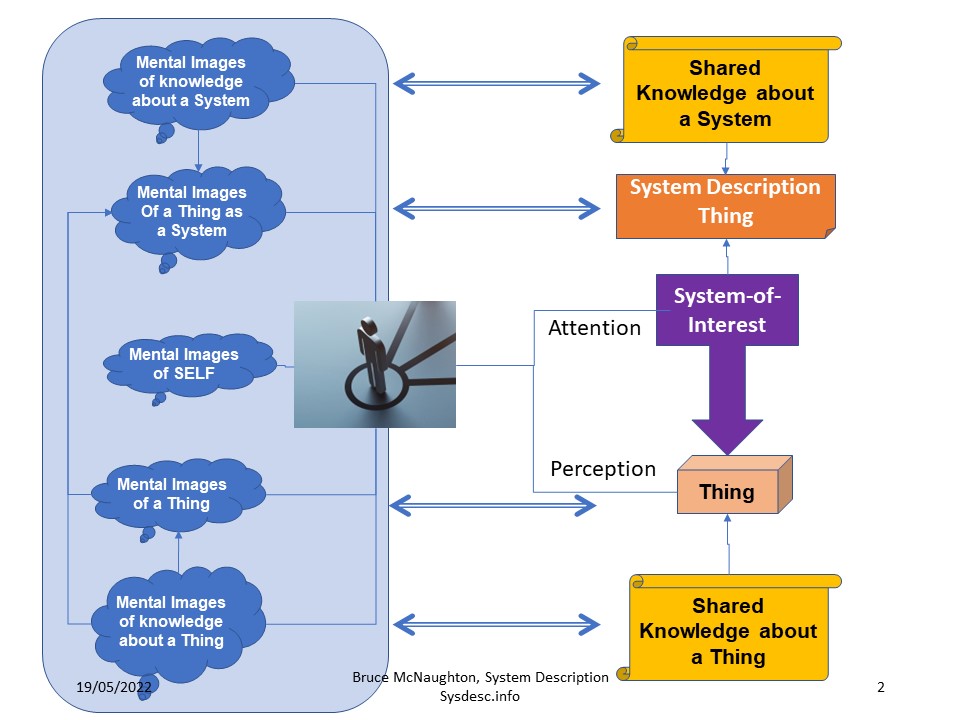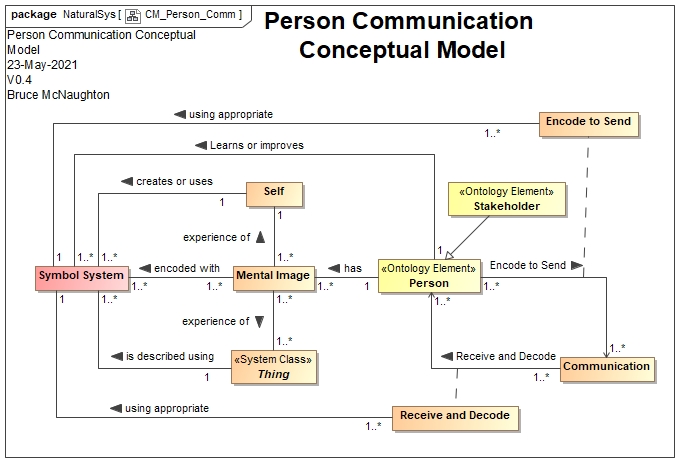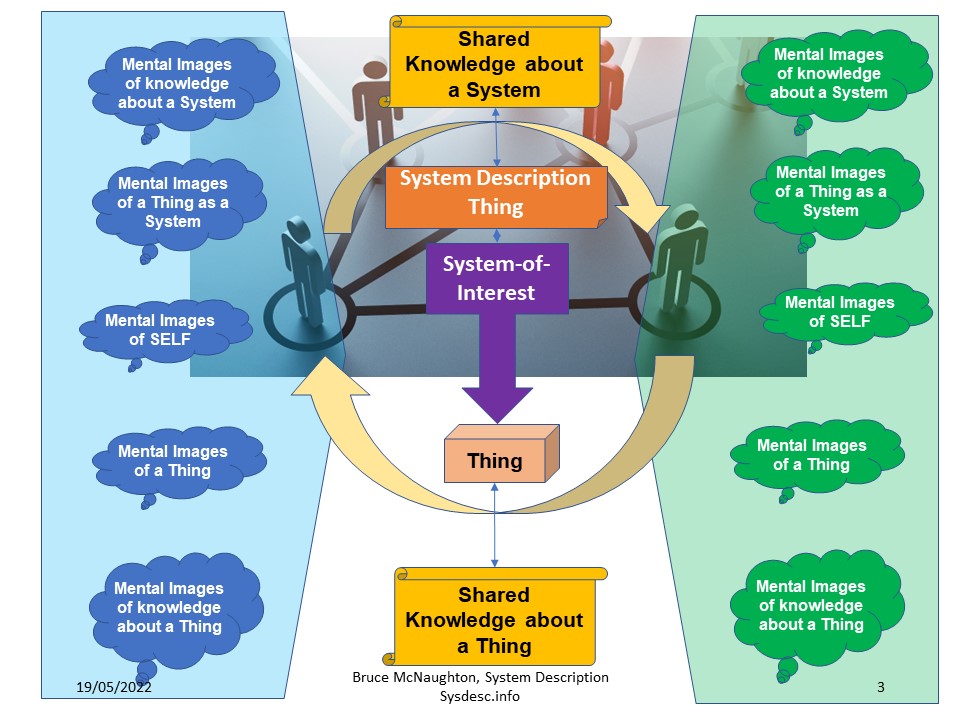Communication between two or more agents requires their Associative Networks synchronised. Synchronised means that they have to come to a convention what set of terms, of what meaning, are going to be used for the time or their communication.
https://sysdesc.info/Content/System/Concepts/SharedMeaning.htm
Skip To Main Content

Shared Meaning through Living Systems
Understanding the thing as a system is basically a social activity involving:
-
A Person as a System.
-
within a Social system.
These are two types of living systems. Both will be explored.
Person as a System
A person is an open system with respect to energy, information and matter and a closed system operationally. This means that person creates their own understanding of the world. The following picture identifies the areas where a person creates their own mental images (Antonio Damasio) or mental models,(Peter Senge) The following picture highlights the areas where each person creates sets of mental images:

Each person creates their own understanding and mental images of the following:
These mental images are unique to the person based upon their interaction with the shared information.
A person encodes their understanding using symbol systems and communicates their knowledge based upon their mental images.

Creation of shared meaning through Social Interaction
A social system consists of social structure (shared knowledge) and a social network (members interacting through communication). The each member of a social network within a social system has their own understanding of any specific item. The following picture shows two members each with their own mental images and the shared items in the social structure.

Through dialogue and conversation (the arrows between the members), create triggers that cause structural changes that may create three outcomes:
-
Align the mental images with the shared documents
-
Ignore the information being shared
-
Respond with feedback to counter the information.
If these shared mental images converge, there will become a shared understanding of the meaning within the various sources. If they diverge, friction and tension may arise until the differences are resolved; or they may not be shared.
As the stakeholders in a system-of-interest are people, the quality of the communication and coherence of understanding makes a significant impact on the value of a shared System Description
Without this understanding, system descriptions will be one person's view of a system.
The underpinning success of this part of the alignment of the system description is dependent upon the leadership in the social system, the shared values and beliefs and the value placed upon open and honest conversation and listening.
Sources for this Model
Other Sources related to the Person as a System.
 Click here to provide feedback on this topic
Click here to provide feedback on this topic
Revision: V1.5, 07-January-2023 />
Customer Driven Solutions Limited©2024
Email:
bruce.mcnaughton@change-aide.com
Tailoring learning through ontological thinking
When trying to influence people, whether through teaching or other means, one important thing to observe is not to force your frame on them. What do we mean by that? Basically, what you perceive as being a meaningful perspective for you, doesn’t necessarily have the same value or meaning to someone else, and realising this is really key to ensuring the successful delivery of learning content. In fact, there’s a really good video that introduces the whole idea of understanding our frame and that of the audience, when trying to influence people. Check it out here.
Document Categorization Using Multilingual Associative Networks Based On Wikipedia
Moreover, instead of treating these translations as special links between two associative networks, we could treat the combined networks as a single associative network, which can be trained as a whole, rather than as two separate networks with some links between them. This also allows us to cover words with multiple possible translations { we simply link the word in one language to each of the translations, using training to set the appropriate weights between them.
In Figure 4 we display an example of two small associative networks, in this case an English and a Dutch one, being combined into a single associative network. In the first step we have two separate associative networks. In the second step, links are added between translated terms. In the final step, a new, larger associative network has been created that combines both networks, and which is ready to be trained as a whole on a multilingual dataset.
Because of the way associative networks spread activation (see Section 2), adding additional connections to nodes in the form of links between translations means the spread from one concept to a related concept becomes weaker. After all, the activation of the node now has to spread over more paths than before. Thus, it would seem at first glance that the quality of the results produced with the associative network should decrease, seeing as how less activation is spread to closely related concepts than before. However, this is not necessarily the case.
Having additional links through translated versions of words may lead to more indirect activation of a node by a related node. For example, in the original Dutch associative network in Figure 4 there is only one path from ‘wandelen’ to ‘lopen’: the direct connection. However in the Dutch-English associative network, there are three paths: the direct connection, a connection through ‘walk’ and a connection through ‘walk’, ‘run’, and ‘rennen’. This means that part of the activation going from ‘wandelen’ to ‘walk’ will loop back to ‘lopen’, which in turn means more activation spreads from ‘wandelen’ to ‘lopen’.
As an alternative solution to the problem of multilingual synonyms, recent research [8, 17, 19] has been done to integrate multilingual synonyms within concept nodes. This research might be used as a basis to create and train an associative network which incorporates the subtleties of both languages directly, without the need to first create and then connect monolingual associative networks. In this research we have not examined that option, instead leaving it as future work.
https://www.facebook.com/groups/125513674232534/permalink/891539347629959/
Daniel Durrant Esteban Trev The story of this image reads like this to me: When I can say, "seems right to me" and you can reply, "seems right to me, too" then together we can act accordingly. Shared intent becomes clearer as we take actions and ask questions based on what "seems right". Does that sound about right to you?
https://www.facebook.com/groups/125513674232534/permalink/882486161868611/?comment_id=883327221784505
M Ichael Josefowicz Dmitry Sokolov You can change if you like, but it might be better to use the language you use. Someplace in some thread I commented that different languages are a feature, not a bug. I have learned much from your approach. It helps alot to get out of the bubble of my thought models. The more we compare and contrast, the more likely it is that we will all gain understandings.
https://www.facebook.com/groups/125513674232534/permalink/854951047955456/?comment_id=875236285926932
Esteban Trev Dmitry, I think I understand... edited the link at LIM to read:
---
Common Intent evolves over time.
The more clearly each can communicate their approaches and the approaches of others, the more a common intent emerges.
job one of a production manager centers in coordinating individuals intent and actions in such a way as to produce the product/service 'desired'
by the production project whilst handling individual intents required for moving to collaborations of intents.
---
It would be nice if there could be a share-to-lim-button to simplify sending a comment from here to there... and comments from there to here... as is the two locations seem as decoupled separate locations... ideally it should be transparent where we be chatting...
Dmitry Sokolov Esteban, thank you for contributing!
I know how hard it can be "writing on someone's page"... Very much appreciated!
Let's see now how synchronisation of our "associative networks" is being realised in IVAN. "The more clearly each can communicate..." by M Ichael is modified. If Michael agreed with the corrections, he will leave them as they are now. If not, he would discuss the issues in this thread. If the differences are critical to you both, both of your versions will be published "on the same page", under your names correspondingly.
Dmitry Sokolov Regarding the reusability of content.
"Idea Visibility" is listed as one of the project success factors:
http://confocal-manawatu.pbworks.com/.../Project...
IVAN suggests keeping different concepts with different levels of complexity on different "pages".
This may be not a good idea for many of us who is used to the "full-text" access to information, all "on one page". That is not a problem. We can publish all the relevant content on the same page (Project Success Factors?). In that case, "Idea Visibility" page will have a note that ALL CONTENT and ALL WORK is being published on another page, with the link on it.
We can also "duplicate", or "synchronise" the content between the pages, if someone likes doing that.
LikeIn our Minds, we can realise nearly any scenario for collaboration, on our mutual agreement.
Dmitry Sokolov Esteban and M Ichael, regarding talking same language.
"Clear Communication" tag is created for you, linked to the "Idea Visibility" page: http://confocal-manawatu.pbworks.com/.../Clear...
From that moment, as soon as you decided to work on "Clear Communication", you would type "Clear Communication" in the Topic Search Bar on LIM, select the "Clear Communication" to open and just follow the link to the "Idea Visibility" page, where all the content on the topic is collected:
http://confocal-manawatu.pbworks.com/.../Idea%20Visibility
If we agreed, for example, that "Idea Visibility" is a slang (by Helmut's terminology), or inconvenient for any other reason, the knowledge network would be restructured with "Clear Communication" being the "core" page for this particular topic.
That's how I see us, specialists from different fields of knowledge, working with sense "hidden" behind our very specialised sets of knowledge expressed in very specialised ways. That's how "synchronisation of our associative networks" can take place, how our content made findable, visible and reusable, i.e. NOT LOST in recurring communications on the same topic again and again.
The Role of Story in Technical Communication
As communicators, then, we are storytellers. Not hero’s-journey storytellers, but still storytellers, because there really isn’t anything else. If we are doing anything more than recording data, we are telling stories.
And the way we tell stories is by stringing words together in ways that evoke stories that the reader already knows. If the reader does not know one of the stories that you invoke, they have to go learn that story before they can move on.
Figuring out what story they have to go learn, however, is not always easy. We usually evoke the sub-stories of our stories by implication. We do so because it is efficient, and because it his how our minds work, how we form language and understand it. But if I do not know what is implied — if the word that does the implying is a word that, like most words, has many denotations, and if the apt denotation is one that you recognize only by context, it is very difficult for an uninitiated reader to find the end of the thread.
This, I suspect, is at the root of the problem know as “the curse of knowledge“. It can be described, per Wikipedia, as “a cognitive bias that leads better-informed parties to find it extremely difficult to think about problems from the perspective of lesser-informed parties.” But what the better-informed party knows, that the lesser-informed party does not know, is stories.
And the reason, I would suggest, that overcoming this bias is so difficult, is that we integrate these stories so tightly into our language, that the invocation and recognition of them becomes essentially unconscious. (Just as language would be appallingly inefficient if we had to explicitly tell all these stories, it would be appallingly inefficient if we had to think them all through in order to speak or write, and explicitly recognize them in order to understand.)
And this is why communication on a broad scale is fundamentally difficult, why people often require multiple sources of information combined with practical experience, to grasp what may seem to us elementary concepts: we have so internalized the stories on which these concepts depend that we have forgotten how to tell them, and that we need to tell them. And for many concepts there are so many stories — stories on stories — to be learned, that there is no shortcut to understanding.
This is why readers don’t read in a straight line. This is why every page should be page one — because every page tells a story, and people need stories in an order and sequence that are unique to them, and that is uncovered only as they learn, for each story they discover depends on other stories they must learn.
It is also why stories should link richly — because it helps the reader to find the stories they need, not just because it is faster than searching, but because links — good links — resolve the ambiguity of implied references to stories.
And it is why we need a disciplined and systematic approach to linking, because that helps overcome the author’s curse of knowledge about what stories they are implying, and even when they are implying them.
http://www.linkedin.com/groupAnswers?viewQuestionAndAnswers=&discussionID=265248803&gid=107180&commentID=159860175
To Tracy: "Knowledge" transfer is quite a simple process to define: it's a synchronisation of the associative networks of a donor and an acceptor. The synchronisation is an interactive and iterative process. The mutual adjustment of the associative, or conceptual, maps stops when the acceptor starts solving this class of problems independently from the donor. I know, it sounds too theoretical.
:0)
On the example of cookies:
the expert shared the cookies protocol adequate to his associative network, i.e. based on the concepts "trivial" to his perception. The learner however did not find the adequate match to these "trivial" concepts in his associative network and made the change request to the expert. The expert was asked to change the protocol to meet the requirements to the certain quality of the product. The expert analysed the problem and added the sub-protocols "missing" from the associative network of the learner.
The "knowledge" transfer described by Emily is finished at this point. It looks like the sub-protocol was not added to the shared associative network describing the "cookies recipe" as a separate entity and linked to the initial protocol from the expert.
This example can be used as the illustration of the concept of the sense domains. The expert created a protocol that makes sense for his practice. This sense domain has the address "cookies recipe, Expert ID" (CR, EID) in the Unified Conceptual Space. However, this sense domain is not applicable to the practice of the Learner. The Expert created two sense domains: "dough consistency, Expert ID" and "out of the oven finishing, Expert ID" linked to the "cookies recipe, Expert ID" at the relevant steps of the protocol.
The Learner was satisfied with the modified protocol and accepted it as the sense domain "cookies recipe, Learner ID". He also created the associative links "soften butter, Learner ID" and "how to make the cookies soft, Learner ID" to the relevant sense domains.
(Please forgive me the mistakes in the content. I am so happy with my wife who does all the cooking at our home!!)
What may happen then is called the synchronisation of the associative networks (in the Unified Conceptual Space).
1. if the modified recipe is accepted by Expert, the ID part of the address is removed, and UCS has just one sense domain "cookies recipe"
2. if 1. is not accepted the "cookies recipe" will have two domains linked by the "parent-child" association. Each of the participants will have a preference to "his" sense domain.
A similar rule is applied to the sense domains created by the change request. If either of participants finds the sense domain unacceptable to his practice the domain will be split by the "ID" co-ordinate.
This can be another illustration that the "knowledge" as a property of an expert doesn't exist as a defined result of his intellectual practice sitting somewhere deep in his mind. The knowledge is re-created and adjusted to the problem actual to the moment. When the problem is solved, the knowledge is either transformed into the protocol, detailed enough for the next "cooking" and stored in UCS, or just thrown away in the believe that nobody will never bake the cookies again, or that the expert will be kind enough to spend his time on the tailoring his protocol again and again.
Reworking Economy
Well-reworked text helps the reader comprehend and integrate points. Readers understand the text better. Responders can use the structure of the post to focus comments better. Those reworking can better assemble the arguments in their mind, to condense them. Finally, good structuring can help one understand ones own ideas better at the time of writing.
Eager reworking yields these benefits more rapidly, and ideally improves the experience of all involved in discussing a topic. It also gives more opportunity for one to develop the skills of reworking.
References:
http://confocal-manawatu.pbworks.com/w/page/63359697/Unified%20Conceptual%20Space
Links
Subcategories
`K
``L
`V
Pages
Live vs Virtual Synchronisation of Accociative Networks
Feasibility of Synchronisation of Integrated Virtual Associative Networks
Pages in Other Languages
Categories
Comments (0)
You don't have permission to comment on this page.